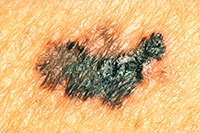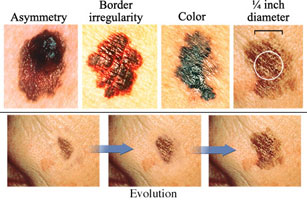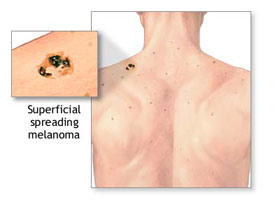Melanoma
Melanoma is a special and dangerous form of moles. Melanoma is the most serious and deadly type of skin cancer. Although they make up the smallest percentage of skin cancers, they cause the highest number of deaths.
Normal Moles
Generally, they are dark brown to black in color, with clear boundaries separating them from the rest of the skin, varying in size from a pencil point to 2-3cm, and are round or oval in shape. They can be flat or raised above the skin.
People may not have any moles at all or may have a small or considerable number. Many of them develop around the age of 20.
Features of moles that direct us towards melanomas include:
- An asymmetric shape of the moles.
- The borders of the moles which are irregular.
- Changes in the color of the moles, i.e., existing moles suddenly change their color.
- Sudden increase in the size of existing moles.
Other changes that should concern us
Itching (scratching) in the area where the mole is located, darkening of its color, or when any small amount of bleeding may occur from it.
But what are the factors that influence?
Many factors influence, but the main ones we can mention are prolonged exposure to the sun's rays, factors related to genetics, etc.
Where are they located?

Melanomas can develop in different parts of the body, but more often they are located in areas exposed to the sun such as: face, shoulders, arms, etc.
Melanomas can also have other localizations outside the influence of solar radiation such as in: mouth, digestive tract, in the eyes.
How should we act if we notice these signs?
We should go to the doctor as soon as possible. The sooner we seek medical help, the better the course of these moles.
Their treatment depends on the stage at which they are presented. Thus, in the early stages of melanomas, a simple surgical excision (removal) of the mole is performed.
If the patient presents in a late stage when the melanoma (mole) has affected the deep layers of the skin or when it has spread to other tissues and organs, i.e., has metastasized, alongside surgical treatment, chemotherapy sessions are also applied.
Statistics
The World Health Organization testifies that about 65,161 people around the world die each year from various forms of skin cancer.
People with more than 50 moles, or with a family history of melanomas, have a higher risk of developing melanomas.
More than 1 million cases of skin cancer are diagnosed in the United States every year.
In conclusion, we can say that early detection of melanomas is important, and for this reason, we should go to the doctor.

